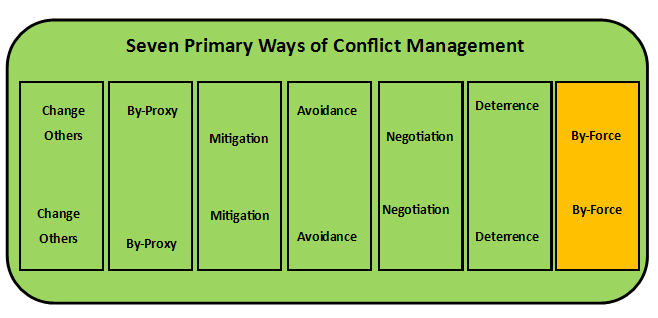When most people think of self-defense, they are usually thinking of the use of By-Force. By-Force is physical self-defense. It is also a form of enforcement. By-Force may be one of the primary ways of self-protection, but it is not reliably effective by itself. The use of By-Force is very closely tied to Deterrence.
While By-Force may be thought of as the last resort or the final option, it should also be thought of as an unreliable option in many situations. While By-Force may succeed spectacularly, it also may fail miserably.
Think of By-Force as a parachute you have packed a few days or many years ago. Maybe it will deploy when you pull the rip-cord or maybe it will not. The longer it has been since you have last used it, the more likely that it will not work as intended. But regardless, you always need to have it available for use.
By-Force is the physical enforcement of your boundaries. It is used when communication has failed. The use of force may be initiated by you pre-emptively, or it may be first applied by your assailant.
The goal of Change Others, Avoidance, Negotiation, and Deterrence is prevention of physical conflict. The goal of By-Force is to stop your assailant’s Intent and/or Means and/or Intent to do you harm with an appropriate physical response(s). An appropriate response is defined legally determined by society. But you are faced with making a decision in the heat of the moment. Therefore, not only is your use of By-Force subject to failure, it is also subject to judgement by society. Failure to use a reasonable amount of force may subject you to criminal penalties and civil lawsuits (a/k/a Over-enforcement).
Once you engage in By-Force, you are in a violent conflict. Prevention has failed. You are now an assault statistic. Invariably, the potential negative consequences of engaging in By-Force are much greater than engaging in Avoidance, Negotiation, and Deterrence. But By-Force may be successful where the others have failed.
In the context physical self-defense, it is common for people to think of it as fighting back against an attacker. In this case, your response to your attacker is going to be combination of instinctive and trained actions heavily influenced by your emotions and prior training and experience. In addition, the effectiveness of your actions will also depend greatly up upon the physical and emotional makeup of your attacker as well as environmental factors.
Many stranger attacks are initiated by relatively lowly motivated attackers. These people are looking for easy victims who will not resist or can be quickly overwhelmed into submission. In this case, the use of By-Force will have a higher chance of success even if the use is technically ineffective. The simple act of resistance may be enough to cause your attacker to disengage. When this happens, By-Force is really a form of communication and a deterrence of a further assault.
But there are also highly motivated attackers who will not give up easily. These people will require a high level use of force response to stop them. Simply resisting is not enough. These people will use tactics and strategies to their advantage. If you are attacked by a highly motivated attacker, the chance of By-Force failing is much greater. Therefore, the best defense against a highly motivated attacker is the use of prevention. You want to avoid them at all costs. You don’t want to rely on By-Force as your only option.
It is also true that many highly motivated attackers are people who know their intended victim. This actually makes sense. It is the perpetrator/victim relationship that creates the high level of motivation to do harm. People who don’t know you don’t care about you. And thus, are usually not highly motivated to do you harm.
There are also many lowly motivated attackers that know their victims. In this case, these attackers use their knowledge of the target as part of their selection process. They attack their victims because they think they will not encounter resistance, particularly the use of By-Force. Therefore, the use of By-Force is more likely to create a successful physical defense.
Most people who come to a self-defense class are looking for “moves” and techniques to use in case of attack. They view assaults only in terms of a physical attack and think the solution is some type of a physical defense. These people fail to take into consideration the other six primary ways of personal safety and how these six ways relate and interact with each other and By-Force. You need to know when it is legal to use By-Force and when it is not legal to use By-Force. You need to know when using by force is likely to make things better and when using By-Force is likely to make things worse.
It is only when By-Force is considered in totality with the other six ways of Change Others, By-Proxy, Mitigation, Avoidance, Negotiation, and Deterrence, and the limitations and risks of By-Force are fully understood that the use of By-Force can become a more viable option for self-defense.
